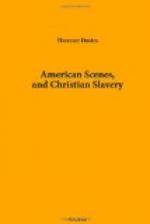And now let us attend the speaker’s funeral. Professor Whipple will be our guide. As we proceed, crowds of coloured people are hastening in the same direction from all quarters. We are at the house. But so great is the throng that it is impossible to get in. Here, however, comes Dr. Cox. “Make room for Dr. Cox!”—“Make room for Dr. Cox!” is now heard on every hand. A path is opened for the great man, and we little men slip in at his skirt. On reaching the room where the remains of the good man lie, we find Dr. Patton and the Rev. Mr. Hatfield. They and Dr. Cox are there in a semi-official capacity, as representing the Presbytery with which Mr. Wright was connected. Louis Tappan, the long-tried and faithful friend of the coloured race, is there also. I am asked to be a pall-bearer: without at all reflecting on the duties and inconveniences of the office, I good-naturedly consent. A white cotton scarf is instantly thrown over my shoulder. There is the coffin; and there is a lifelike portrait of Mr. Wright hung up against the wall, and looking as it were down upon that coffin. But you can see the face of Mr. Wright himself. The coffin-lid is screwed down; but there is a square of glass, like a little window, just over the face, as is generally the case in America, and you can have a view of the whole countenance.
A black man reads a hymn, and, in connection with it, begins an address in a very oracular style, and with very solemn pauses. A hint is given him not to proceed. They sing. Mr. Hatfield delivers an appropriate address. A coloured minister prays, sometimes using the first person singular, and sometimes the first person plural; also talking about the “meanderings of life,” and a great deal of other nonsense.




